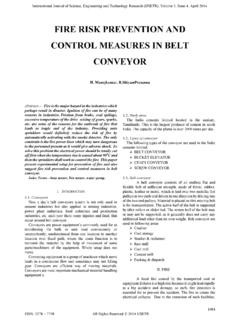Transcription of HEART RATE MONITORING SYSTEM USING FINGER TIP …
1 International Journal of Science, Engineering and Technology Research (IJSETR), Volume 5, Issue 1, January 2016 84 ISSN: 2278 7798 All Rights Reserved 2016 IJSETR HEART RATE MONITORING SYSTEM USING FINGER TIP THROUGH ARDUINO AND PROCESSING SOFTWARE Bandana Mallick1 Ajit Kumar Patro2 of Electronics & Communication Engineering , GIET,Gunupur, Odisha, India of Electronics & Instrumentation Engineering, GIET, Gunupur, Odisha, India Abstract - Technological innovations in the field of disease prevention and maintenance of patient health have enabled the evolution of fields such as MONITORING systems.
2 HEART rate is a very vital health parameter that is directly related to the soundness of the human cardiovascular SYSTEM . HEART rate is the number of times the HEART beats per minute, reflects different physiological conditions such as biological workload, stress at work and concentration on tasks, drowsiness and the active state of the autonomic nervous SYSTEM . It can be measured either by the ECG waveform or by sensing the pulse - the rhythmic expansion and contraction of an artery as blood is forced through it by the regular contractions of the HEART .
3 The pulse can be felt from those areas where the artery is close to the skin. This paper describes a technique of measuring the HEART rate through a fingertip and Arduino. It is based on the principal of photophelthysmography (PPG) which is non-invasive method of measuring the variation in blood volume in tissue USING a light source and detector. While the HEART is beating, it is actually pumping blood throughout the body, and that makes the blood volume inside the FINGER artery to change too. This fluctuation of blood can be detected through an optical sensing mechanism placed around the fingertip.
4 The signal can be amplified and is sent to arduino with the help of serial port communication. With the help of processing software HEART rate MONITORING and counting is performed. The sensor unit consists of an infrared light-emitting-diode (IR LED) and a photo diode. The IR LED transmits an infrared light into the fingertip, a part of which is reflected back from the blood inside the FINGER arteries. The photo diode senses the portion of the light that is reflected back. The intensity of reflected light depends upon the blood volume inside the fingertip.
5 So, every time the HEART beats the amount of reflected infrared light changes, which can be detected by the photo diode. With a high gain amplifier, this little alteration in the amplitude of the reflected light can be converted into a pulse. Key Words: HEART rate sensor, HEART rate measurement, photophelthysmography (PPG),IR LED,. Arduino Software I. INTRODUCTION A HEART rate monitor is a personal MONITORING device that allows a subject to measure their HEART rate in real time or record their HEART rate for later study. Early models consisted of a MONITORING box with a set of electrode leads that attached to the chest.
6 The HEART rate of a healthy adult at rest is around 72 beats per minute (bpm) & Babies at around 120 bpm, while older children have HEART rates at around 90 bpm. The HEART rate rises gradually during exercises and returns slowly to the rest value after exercise [2]. The rate when the pulse returns to normal is an indication of the fitness of the person. Lower than normal HEART rates are usually an indication of a condition known as bradycardia, while higher is known as tachycardia. HEART rate is simply measured by placing the thumb over the subject s arterial pulsation, and feeling, timing and counting the pulses usually in a 30 second period.
7 HEART rate (bpm) of the subject is then found by multiplying the obtained number by 2. This method although simple, is not accurate and can give errors when the rate is high. More sophisticated methods to measure the HEART rate utilize electronic techniques. Electro-cardiogram (ECG) is one of frequently used method for measuring the HEART rate. But it is an expensive device. Low-cost devices in the form of wrist watches are also available for the instantaneous measurement of the HEART rate. Such devices can give accurate measurements but their cost is usually in excess of several hundred dollars, making them uneconomical.
8 So this HEART rate monitor with a temperature sensor is definitely a useful instrument in knowing the pulse and the temperature of the subject or the patient. a. Significance Of HEART The HEART acts as a pump that circulates oxygen and nutrient carrying blood around the body in order to keep it functioning. When the body is exerted the rate at which the HEART beats will vary proportional to the amount of effort being exerted. By detecting the voltage created by the beating of the HEART , its rate can be easily observed and used for a number of health purposes.
9 HEART pounds to pump oxygen-rich blood to your muscles and to carry cell waste products away from your muscles. The HEART International Journal of Science, Engineering and Technology Research (IJSETR), Volume 5, Issue 1, January 2016 85 ISSN: 2278 7798 All Rights Reserved 2016 IJSETR rate gives a good indication during exercise routines of how effective that routine is improving your health. II. PROPOSED METHOD A. SYSTEM Description Current technology consists of optical and electrical monitors. The electrical method provides a bulky strap around one s chest.
10 The optical method does not require the strap and can be used more conveniently than the electrical method. There are many constraints in producing a HEART monitor. First, the technology used to measure the pulse has to be determined. A cost efficient way of measuring the pulse is the combination of a led and photo-sensor. Electrical Method The chest strap of a HEART rate monitor uses electrodes to monitor the electric volts that occur when your HEART beats. The receiver detects this information from the electrodes via radio signal from the chest strap.









